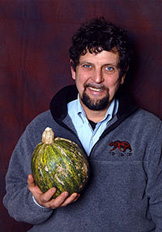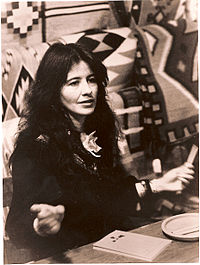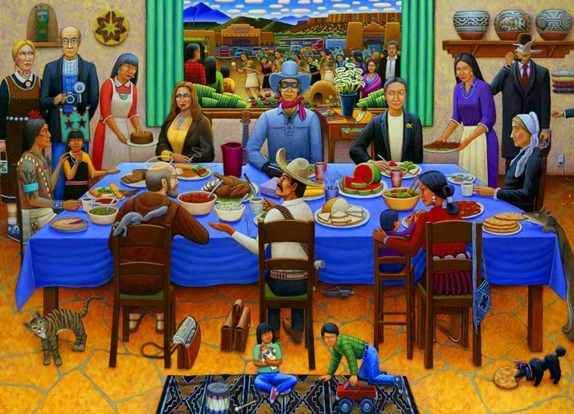Recipes and types of foods eaten can be a great way to explore history. Each year our Thanksgiving tables give us lessons in history and culture that connect us through the choices we make about what we eat. Each family's menu tells us a lot about who they are and who their ancestors were.
When asked what a family eats on Thanksgiving, the typical answer is "You know the usual, turkey, pumpkin pie...". But, if we look closer we will find very interesting food choices and recipes that are far from the "usual". For instance in my family, who are Native American, we have hard boiled eggs soaked in beets and beet juice. This can be traced back to a very early history of using boiled eggs in soups, stews and many other combinations. We also eat a raw cranberry mixture with apples and oranges. This can be traced back to very early ways of preparing cranberries, before they were boiled and mashed into a mold. We have baked beans, and yet another food that can trace it's history to very early times. So, even the seemingly "usual" menu can have hints of our history.
The recipes included in the following pages reflect the historic foods of the Wampanoag and Pilgrims, but many of the recipes also demonstrate the transformation of these foods through a combination of both Pilgrim and Wampanoag cuisines and what that says about the America we live in today.
There are also recipes that involve foods that have almost disappeared from our contemporary tables. When a food disappears, we don't just lose a flavor; we lose an experience, one that helps to make a place unique, worth protecting and worth caring about. These recipes are intended to remind us of where we’ve been and to help us consider where we’re going and who we are becoming.
Click on these links to see more
What was served at the first Thanksgiving
Wampanoag RecipesPilgrim Foods
Popcorn?
THE FOLLOWING ARE RECIPES THAT MIGHT HAVE BEEN PRESENT AT THE "FIRST" THANKSGIVING
Salads
Breads
Cranberries
StrawberriesRaspberries
Pumpkin
Squash
Corn
Sunflower Seeds
Fish and Seafood
Turkey
Meats
Cooking Methods
As an additional note not only were the foods and recipes during the "First" Thanksgiving different, the cooking methods were also very different. Here is a very short video about cooking in a clay pot. It was filmed at Plimoth Plantation.
Found at:  https://www.youtube.com/watch?v=Hiw5-aOqE30&list=TLee6d21_Y-AI
https://www.youtube.com/watch?v=Hiw5-aOqE30&list=TLee6d21_Y-AI
Roasting Cod Fish at the Wampanoag Homesite Plimoth Plantation
Try to recall the most remarkable lunch you’ve ever had in a grade school...
We thought it would be interesting to share the following story by Gary Paul Nabhan, award winning agricultural ecologist, ethnobotanist, and writer. He is considered a pioneer in the local food movement and the heirloom seed saving movement.

"Mine was remarkable not only because of the food that was served, but also because of the people—both young and old—with whom I ate. It was the people’s cultural traditions and their link with their distinctive landscape through food that made the entire experience so memorable.
It happened at a primary school on the Gila River Indian Reservation, where the River Pima currently suffer from an epidemic of obesity and diabetes. But just a few blocks away from the school was a Senior Center, where elderly farmers met. They had grown up in the days when the native desert crops they raised prevented their people from the suffering associated with diabetes and obesity.
When the school teachers asked for some lessons about the value of fresh, healthy, ethnic foods from the Pima past, I suggested that we invite the elders over to help the students prepare for an old-fashioned Thanksgiving—one in which all foods were locally grown, and were part of the Pima heritage long before the Pilgrims and the Wampanoag shared their first Thanksgiving.
Over the weeks preceding the feast, elders came into the classroom to explain to the students how to harvest and prepare various traditional foods. But they did more than that. Through their stories about the foods, they offered us lessons in agriculture, biology, history, geography, nutrition, and cultural studies. By the time we celebrated this timeless feast, we had been nourished not only by the foods themselves, but also by the elders' stories and songs, their humor, and their sadness over recent changes in the diet.
Imagine, in your own school, a meal that tastes of the very landscape and watershed in which the cafeteria sits. A meal that tastes of the stories first told by people who farmed or fished nearby, long before the school was built. Imagine a day when each school lunch will be a celebration, a thanks-giving for both nature and culture. Hunger for that taste."
As an addition to Gary Paul Nabhan's story we thought we would include this poem about the kitchen table by Joy Harjo (Muscogee - Creek) internationally known author, poet, performer and educator.

Perhaps the World Ends Here
The world begins at a kitchen table. No matter what,
we must eat to live.
The gifts of earth are brought and prepared, set on the
table so it has been since creation, and it will go on.
We chase chickens or dogs away from it. Babies teethe
at the corners. They scrape their knees under it.
It is here that children are given instructions on what
it means to be human. We make men at it,
we make women.
At this table we gossip, recall enemies and the ghosts
of lovers.
Our dreams drink coffee with us as they put their arms
around our children. They laugh with us at our poor
falling-down selves and as we put ourselves back
together once again at the table.
This table has been a house in the rain, an umbrella
in the sun.
Wars have begun and ended at this table. It is a place
to hide in the shadow of terror. A place to celebrate
the terrible victory.
We have given birth on this table, and have prepared
our parents for burial here.
At this table we sing with joy, with sorrow.
We pray of suffering and remorse.
We give thanks.
Perhaps the world will end at the kitchen table,
while we are laughing and crying,
eating of the last sweet bite.
And as a final note, we wanted to include a humorous look at the Feast table through the visual art of David Bradley, a Minnesota Chippewa artist known for his social critiques and socialpolitcal humor.
This painting depicts a Southwestern Native Pueblo Feast Day. During these Feast Days which include Christian saints -adopted during Colonial conquest - there are dances to maintain harmony with the spiritual and natural worlds. After the dances, it is very common for the public to be invited to share food with Pueblo families in their homes. In this satirical vision, David Bradley depicts figures such as Bill and Hillary Clinton, artist Georgia O'Keeffe, and Tonto (the Lone Ranger's sidekick) at the Feast table.
Pueblo Feast Day

Painting by David Bradley (White Earth Ojibwe artist) titled Pueblo Feast Day